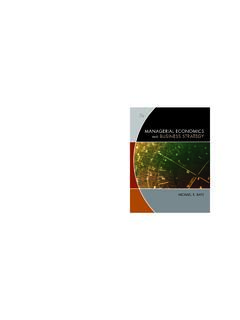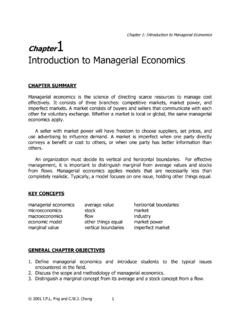Transcription of MANAGERIAL ECONOMICS (FT 114)
1 Page 1 of 19 UNIT-WISE QUESTION BANK MASTER OF BUSINESS ADMINISTRATION (MBA) (FIRST SEMESTER) MANAGERIAL ECONOMICS (FT 114) Time: 3 Hours [Maximum Marks: 70] [Passing Marks: 28] Note: 1. Part-A: 10 Objective/Multiple Choice questions each 1 marks=10 marks 2. Part-B: 10 Very short answer type questions each marks=15 marks 3. Part-C: 10 Short answer type questions each marks =25 marks 4. Part-D: 4 Long answer type questions each 5 marks=20 marks 5. Attempt all parts as directed PART-A (Objective / Multiple Choice Questions each 1 marks) UNIT-1 1. MANAGERIAL ECONOMICS helps in decision making through application of (a) economic theory only (b) economic theory and methods of science (c ) economic theory and methods of decision science (d) None of the above 2.
2 MANAGERIAL ECONOMICS uses (a) Micro ECONOMICS only (b) Macro ECONOMICS only (c ) Both Micro & Macro ECONOMICS (d) None of the above Page 2 of 19 3. Business Profit is .. (a) An accounting concept (b) An accrual concept (c ) Both (a) and (b) (d) None of the above 4. Business Profit = (a) Total Sales Revenue Implicit Costs (b) Total Sales Revenue Explicit Costs (c ) Total Sales Revenue Total Costs (d) None of the above 5. Implicit Cost refers to (a) Marginal cost (b) Total Average Cost (c ) Opportunity cost of resources (d) None of the above 6. economic Profit = (a) Sales Revenue (Implicit Costs + Explicit Costs) (b) Sales Revenue Explicit Costs (c ) Sales Revenue Implicit Costs (d) None of the above 7.
3 Analysis of an industry falls under: (a) Macro ECONOMICS (b) Micro ECONOMICS (c ) Financial ECONOMICS (d) Environmental ECONOMICS 8. The basic economic problem is the problem of (a) Abundance of resources (b) Scarcity of resources (c ) Human Resources (d) None of the above UNIT-2 9. Change in the demand of smartphones due to increase in its price is (a) Increase of its demand (b) Decrease of its demand (c ) Contraction of its demand (d) None of the above Page 3 of 19 10. In case , a slight change in the price will make greater change in demand. (a) Inelastic (b) Elastic (c ) Perfectly elastic (d) Perfectly inelastic 11.
4 Normal demand curve of a commodity has: (a) has positive slope (b) has negative slope (c ) Is parallel to the base line (d) None of the above 12. When the price of Coffee increases and the demand for Coldrink increase (a) Coffee and Coldrink are (b) ) Coffee and Coldrink are complimentary for each other (c ) Coffee and Coldrink are noncomplimentary for each other (d) None of the above 13. Which of the followings can be regarded as an exception to law of demand (a) Cases of snob appeal ( jewels) (b) Cases in which consumer judges quality by price (c ) Cases of Giffen goods (d) All of the above 14.
5 Consumer surplus is the state where a consumer willing to pay higher price actually pays (a) Higher price (b) Lower price (c ) Sometimes higher & sometimes lower price (d) None of the above 15. Under Law of variable proportions a single factor is (a) Constant (b) Variable (c ) Both constant and variable (d) None of the above Page 4 of 19 16. Law of variable proportions is also known as (a) Law of Diminishing Returns (b) Law of Increasing Returns (c ) Law of Constant Returns (d) None of the above 17. Production function is (a) Purely an economic relationship between inputs and outputs (b) Purely a technical relationship between inputs and outputs (c ) Both (a) and (b) (d) None of the above 18.
6 Return to scale means (a) Change in output when only some factors of production are increased (b) Change in output when only variable factors of production are increased (c ) Change in output when only fixed factors of production are increased (d) Change in output when all factors of production are increased simultaneously UNIT-3 19. In ECONOMICS Market means: (a) A physical place to buy and sell goods / services (b) A Mechanism to exchange goods / services for a consideration (c ) Local area market only (d) None of the above 20. In Perfect competition products are: (a) Heterogeneous (b) Homogeneous (c ) Differentiated (d) None of the above 21.
7 In Perfect competition firms are: (a) Price maker (b) Price influencer (c ) Price taker (d) None of the above 22. In Perfect competition factors of production are: (a) Perfectly mobile (b) Perfectly immobile (c ) Both (a) and (b) (d) None of the above Page 5 of 19 23. In Perfect competition selling cost is: (a) Very high (b) Very less (c ) Nothing (d) None of the above 24. In Perfect competition firms are : (a) Not Free to enter or exit (b) Free to enter or exit (c ) Sometimes free and sometimes not free to enter or exit (d) None of the above 25. In Perfect competition firms and consumers are : (a) Small (b) Few (c ) Large (d) None of the above 26.
8 In Imperfect competition products are : (a) Heterogeneous (b) Homogeneous (c ) Differentiated (d) None of the above 27. In Imperfect competition firms are: (a) Price maker (b) Price influencer (c ) Price taker (d) None of the above 28. In Imperfect competition factors of production are: (a) Perfectly mobile (b) Perfectly immobile (c ) Both (a) and (b) (d) None of the above 29. In Imperfect competition selling cost is: (a) Very low (b) Substantial (c ) Nothing (d) None of the above 30. In ECONOMICS competition refers to the market structure which means : (a) The extent to which individual firm have the power to influence market price (b) Competition among firms (c ) Number of firms (d) None of the above 31.
9 In monopoly a single firm is selling : (a) A single product for which there are close substitutes (b) Two product for which there are no close substitutes (c ) A single product for which there are no close substitutes (d) None of the above Page 6 of 19 32. A monopolist is: (a) Price maker and not price taker (b) Price influencer (c ) Price taker and not price maker (d) None of the above 33. A monopolist can: (a) Fix price and output (b) Either fixes price or output (c ) Fix output (d) None of the above 34. In Monopoly firms entry of other firms are : (a) Free (b) Restricted (c ) Sometimes free & sometimes restricted (d) None of the above 35.
10 Price discrimination refers to : (a) Selling the same commodity at same prices to buyers (b) Selling the same commodity at different prices to buyers (c ) Selling the different commodity at same prices to buyers (d) None of the above 36. A seller under perfect competition : (a) Can practice price discrimination (b) Can not practice price discrimination (c ) Sometimes can practice price discrimination (d) None of the above UNIT-4 37. Balance of payments of a country includes : (a) Current account (b) Capital account (c ) Monetary account (d) All of above 38. Balance of payments of a country includes: (a) Balance of trade (b) Capital receipts & payments (c ) Saving & investment account (d) Both (a) and (b) 39.








